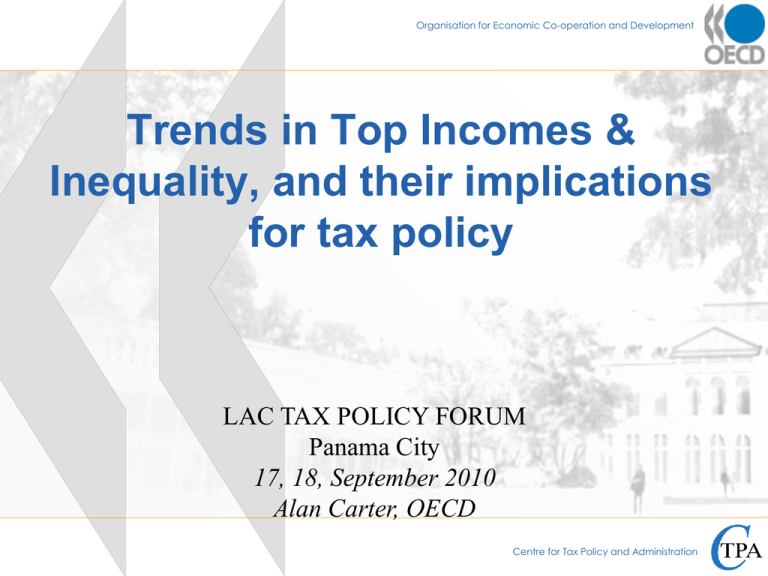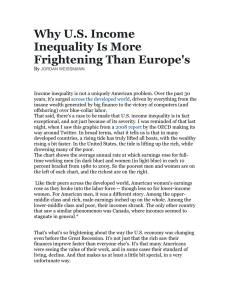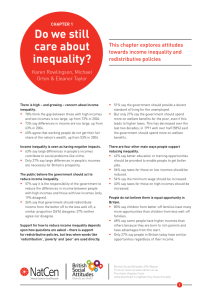Trends in Top Incomes & Inequality, and their implications for tax policy
advertisement

Organisation for Economic Co-operation and Development Trends in Top Incomes & Inequality, and their implications for tax policy LAC TAX POLICY FORUM Panama City 17, 18, September 2010 Alan Carter, OECD Centre for Tax Policy and Administration Today’s presentation “Growing Unequal?”(2008) and ongoing OECD 2 work underway on tax and inequality What has happened to top incomes? What has happened to inequality? Explanations of trends in top incomes The effects of top income taxes. Other possible tax policy responses. OECD’s Growing Unequal Study: Income Distribution and Poverty in OECD Countries Distribution of income over time and across countries Measurement issues and impact of demographic and household formation Redistribution and cash transfers (Robin Hood vs the Piggy Bank motive) Measuring poverty and inflows and outflows Intergenerational Mobility (e.g. via impact of assortative mating) Effect of publicly provided services (housing, health and education) Work underway in WP2 on tax and inequality A preliminary version of a paper has been prepared that aims to: Provide the empirical background of changes in high income shares and inequality. Examine explanations of these changes. Summarise the available evidence of the effects of income taxes on reported incomes and revenue. Encourage delegates to provide further data and national analysis 4 How the analysis may be developed Examine possible tax policy responses in more detail, such as: • Taxation of capital gains, including ‘carried interest’, • Taxation of wealth, estates and inheritances, • Further analysis of income tax changes. Provide more data analysis: • More countries and years, • The role of top incomes in overall inequality. 5 What has happened to top incomes? Results are mainly based on tax data, excluding 6 capital gains. Results relate to pre-tax (market) incomes. All countries for which data are available experienced marked reductions in top 1% shares in the first half of the last century. Most have shown an increase in the top 1% shares in the past 30 years, but the extent of increase has varied widely. Some more detail on recent changes Australia, Canada, Ireland, New Zealand, UK and 7 US show the largest increases. Denmark, Finland, France, Italy, Japan, Norway, Portugal, Spain and Sweden show smaller increases. Germany shows no trend. The Netherlands and Switzerland show a slight continuing decline. What about other shares? For most countries, income concentration within the high income groups has increased: Shares of the top 0.5%, 0.1%, 0.05% and 0.01% increase by a greater proportion than the share of the top 1%. Shares of the top 5% and 10%, increased by a smaller proportion than the share of the top 1%. 8 What categories of income increased the top shares? For countries with available data, inclusion of capital gains increased the share of top incomes. For Canada, France, Italy, Japan, Spain and US earnings were more important than capital income. However, the reverse appears to be true in Australia, Finland and Sweden. 9 What has happened to inequality? Most countries with available data have 10 experienced an increased in inequality of market income in recent years. But, the Netherlands had no overall trend, Germany and Japan did experience an increase despite no increase in the top earners share of income France experienced an overall reduction of inequality in market income. UK Data: Financial intermediation and high incomes Survey of Personal Incomes 2007-08: Taxpayers with top incomes by INDUSTRY Agricultural, Hunting & Fishing Mining and Quarrying Manufacturing Electricity, Gas and Water supply Construction Wholesale and retail trade Hotel and Restaurants Transport, Storage and Com m unication Financial Interm ediation Real estate, Renting and Business activities Public adm inistration and Defence Education Health and Social w ork Other com m unity services Other Services Extra-territorial organisation and bodies Unclassified Individuals w ith pension incom e 1 All all taxpayers (000s) 269 47 2,700 173 2,080 3,500 1,000 1,470 1,040 4,210 1,220 2,900 2,540 1,140 228 2 237 7,710 32,500 Source: Survey of Personal Incom es 2007-08 .. not available or sample size too small to produce a reliable estimate Notes: Table covers taxpayers only. Top 10% etc. ranked by total income for income tax before deductions. 1. Individuals with any pension income (state or private pension). col % 0.8 0.1 8.3 0.5 6.4 10.8 3.1 4.5 3.2 13.0 3.8 8.9 7.8 3.5 0.7 0.0 0.7 23.7 100.0 top 10% (000s) 19 17 303 30 199 278 29 143 307 759 120 184 225 99 20 .. 41 472 3,250 col % 0.6 0.5 9.3 0.9 6.1 8.6 0.9 4.4 9.5 23.4 3.7 5.7 6.9 3.0 0.6 .. 1.2 14.6 100.0 top 5% (000s) 11 10 134 11 79 140 14 66 202 424 33 52 128 50 12 .. 25 234 1,620 col % 0.7 0.6 8.2 0.7 4.9 8.7 0.8 4.1 12.5 26.1 2.0 3.2 7.9 3.1 0.7 .. 1.5 14.4 100.0 top 1% (000s) 2 2 21 1 12 24 2 8 69 92 2 4 26 10 3 .. 6 41 325 col % 0.7 0.6 6.4 0.3 3.6 7.4 0.7 2.3 21.2 28.5 0.7 1.3 8.1 3.0 0.8 1.9 12.5 100.0 top 0.5% (000s) 1 1 9 0 5 11 1 3 42 49 1 1 7 6 1 .. 4 20 162 col % 0.8 0.5 5.7 0.3 3.3 6.8 0.6 2.0 25.8 30.2 0.5 0.8 4.4 3.4 0.8 2.2 12.1 100.0 Explanations of recent trends in top incomes Tax reductions, producing: • A reduction in avoidance and evasion • Increased work effort and entrepreneurship • Increased ability to build wealth International trade and technical change: • Increasing the demand for skilled labour Greater use of performance related pay Erosion of pay norms Increased income of ‘stars’ 12 The effects of top income taxes Elasticities of income with respect to (1-t): • ‘Broad income’ = 0.12 (work effort effect) • Taxable income = 0.4 (work and compliance) • For high incomes = 0.57 • For low incomes = 0.18 So, an increase in marginal tax rate from 50% to 51% would reduce broad income by 0.24% but taxable income by 0.48%. Tax revenue may not increase. 13 Other possible tax policy responses (1) Increase taxation of capital gains This is suggested by important contribution of capital gains to the increased share of top incomes. It would increase the taxation of ‘carried interest’ and many forms of bonuses, which could be regarded as labour income. It would raise problems with inflationary gains and could harm venture capital. 14 Other possible tax policy responses (2) Increase use of taxes on wealth, estates and inheritances: Goes against recent trends in OECD countries. There are arguments that taxes on estates and inheritances are not very distortionary It would be possible to improve the design of net wealth taxes to reduce scope for abuse. 15 Other possible tax policy responses (3) Some other possibilities: Increase taxation of real property. Reduce the differences between taxation of capital and labour incomes. Remove special regimes to attract highincome workers. Improve cross-border enforcement of tax laws. 16 But ..Unintended Consequences? If the main source of increased income inequality at the top end was mainly financial sector bonuses for “superstars” changes to financial sector regulation and risk taking may result in reversal of recent income trends absent of any significant tax policy change: • Implication is future changes may have relatively larger impact on other sectors and economic growth than current thinking allows for. Greater tax and redistribution may lead to long term social problems such as generations of workless households, and a breakdown in traditional family structures incentivised by tax and benefit structures • Importance of OECD Making Work Pay Agenda International Tax Dialogue 4th Global Conference on Tax and Inequality ITD conference late 2011 in Egypt to address this key issue. Detailed agenda still under discussion but an opportunity for senior tax policy makers and administrators to discuss further: • The empirical evidence • Possible tax responses and their overall desirability • Opportunities for co-operation and learning from best practice • Tax systems and their impact on state legitimacy and capability:

